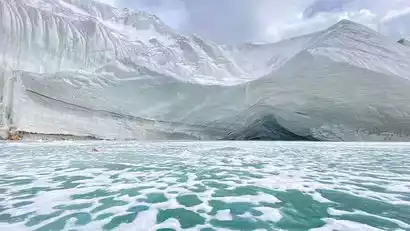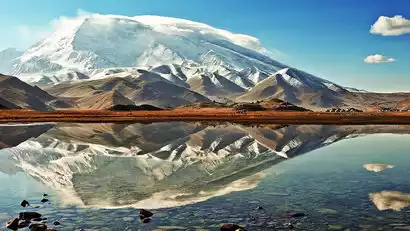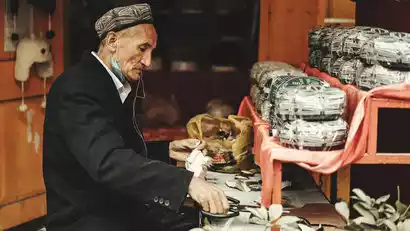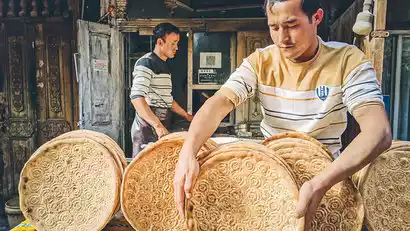Day 1: All Locations → → Korla (★All-day gathering day)
All day
Tourists from all over the country, heading to Korla, the gateway city of southern Xinjiang, go to the meeting hotel on their own and report "China-Travel Note + Name" to the front desk when checking in.
Korla, a strategic point on the central route of the ancient Silk Road and a crucial transportation hub between northern and southern Xinjiang, boasts a high-speed rail station and an airport. Korla is also known as the "Pear City" for its renowned production of the world-renowned "Korla Fragrant Pear." Early arrivals can visit the Bazhou Museum and encounter the Loulan beauties unearthed from the Lop Nur ruins; stroll along the Peacock River and encounter migrating wild swans; and in the evening, savor freshwater fish from Bosten Lake. Korla's red willow barbecue is also excellent.
Border Pass Description: (Updated on July 7)
The team will go together on D5 to apply for a border pass, one per person (bring ID card, apply in person); children under 16 years old: must be accompanied by their parents (bring household registration book + ID card).
Traffic Tips:
Korla Railway Station: There is an intercity high-speed train from Urumqi Station to Korla Station, which takes 3-4 hours. It is convenient to take a taxi from the railway station.
Korla Airport: It has domestic flights and is not far from the city center. A taxi is about 30-45 yuan. It is easy to get a taxi.


Day 2 Korla → Kizil Thousand Buddha Caves → Tianshan Red Stone Forest → Kuche Palace → Kuche
·morning
After breakfast, we will depart for Kuqa, formerly known as Qiuci, an important node on the "Ancient Silk Road" with a strong exotic atmosphere.
We'll first visit the Kizil Thousand Buddha Caves, a massive grotto complex in Xinjiang known as the "Second Mogao Grottoes." Predating the Dunhuang Mogao Grottoes by over a century, it's a key part of the Silk Road World Heritage Site. For millennia, Buddhism flourished here, with numerous monks. It was from here that Buddhism spread eastward to the Central Plains.
·afternoon
Head to China-TravelNote's newly discovered hidden gem, the Tianshan Red Stone Forest. The Red Stone Forest is composed of reddish-brown Yardang wind-eroded landforms. Millions of years of wind and rain erosion in an arid environment have shaped the rock and soil into a diverse array of valleys, peaks, terraces, and pillars. Within the winding gullies, large and small, layers of brown-red, yellow-green, and gray-green earthen mounds overlap, resembling a deserted historic city.
Visit the Kuche Prince's Palace. Built in 1759 by Emperor Qianlong of the Qing Dynasty, the palace was specially commissioned by Han Chinese craftsmen from the interior of China to honor a local Uyghur leader for his contributions in suppressing a rebellion. Expanded by eleven successive princes, the palace boasts both Central Plains Han cultural styles and Xinjiang Uyghur architectural features. Stroll along Restan Road in Kuche Old Street. Restan means "market" in Uyghur. This densely packed street features traditional shops, and you can also take photos with the colorful carved wooden doors.


Day 3 Kuqa → Kuqa Grand Temple → Wensu Grand Canyon → Aksu
·morning
After breakfast, we will depart for Kuqa Grand Mosque (exterior view), which is the second largest mosque in Xinjiang, second only to the Id Kah Mosque in Kashgar, with a history of 460 years.
·afternoon
Depart for the Wensu Grand Canyon (also known as the Tomur Grand Canyon). The Wensu Grand Canyon boasts unique salt karst, Danxia, yardang, and sub-yardang landforms. It was once a crucial route on the ancient Muzhat Road, connecting the northern and southern Tianshan Mountains. Within the canyon, the rock formations are clearly defined, with folds formed by compression. Millions of years of wind and rain have eroded the canyon, creating a unique landscape of towering cliffs, towering peaks, and jagged, bizarre, and vibrant colors. We'll enter by a wild shuttle bus, journeying through the spectacular canyon, marveling at the wonders of nature and gazing down at the breathtaking city of mountains. On clear days, we'll even be able to see Tomur Peak, the highest peak in the Tianshan Mountains.
After having fun, we went to Aksu, the city of apples, to rest.


Day 4 Aksu → Yarkand Khan Palace or Yarkand Khanate Mausoleum → Private Desert Camp (Rich Experience Activities + Desert Camping)
·morning
After breakfast, we will leave for Shache County to visit the Yarkand Khan Palace (also known as the Shache Intangible Cultural Heritage Expo Park). It is a film and television base built on the site of the former Yarkand Palace. The exquisite brick carvings, arches, domes, symmetrical figures, regular patterns, and colorful colors perfectly restore the luxury of the Islamic palace.
Important note: The Yarkand Khanate Palace is currently under renovation. If it is not open by summer, we will visit the palace from outside and visit the Yarkand Khanate Mausoleum as an alternative.
·afternoon
Heading to the Taklamakan Desert, China's largest desert, China-TravelNote has selected a desert camp with a distinct southern Xinjiang feel, offering a variety of unique experiences!
Kumaqi production experience
Kumaqi is a traditional delicacy originating from southern Xinjiang. It can be considered a desert flatbread or desert pizza. We can make Kumaqi by ourselves and experience the original delicacy of southern Xinjiang!
Desert Village Afternoon Tea
Enjoy a leisurely afternoon tea in the shade of a tree in an ancient village on the edge of the desert
National style singing and playing
Watch an authentic ethnic singing performance and learn about the traditional instruments of ethnic minorities
camel cart
Take a traditional camel cart and leisurely journey deeper into the desert, experiencing the ancient charm of the Silk Road caravans
Desert Camp
Check out the beautiful scenery of the camp, experience the thrill of sandboarding, play frisbee, climb the sand dunes for a panoramic view, and watch the sunset over the desert with friends
·night
As night falls, enjoy dinner at the desert camp (fruit + pilaf + yogurt + barbecue + mutton soup, etc.)
Tonight, China-TravelNote has specially arranged a stay at a desert camp, where you can sleep under the stars! The silence of the desert and the brilliance of the starry sky intertwine to create a breathtakingly beautiful scene. Under the stars, the desert feels like a stage set just for us, and exciting activities await you this evening.
Camp evening activities: ① Nighttime light hiking ② Starry sky meditation ③ Desert Heart Fireworks ④ Twelve Muqams + Daolang Muqam live performance ⑤ Maixilaipu bonfire


Day 5: Taklamakan Desert Sunrise → Yingjisha Earthenware Experience → Kashgar
·morning
In the morning, wake up with the sun in the desert. Interested tourists can get up early and wait for the sunrise in the Taklamakan Desert on the sand dunes.
·morning
After breakfast, we'll depart the desert camp and head to Yingjisha County. Visiting the home of an intangible cultural heritage inheritor, we'll learn about and personally experience the ancient Western Region handicraft of earthenware pottery, experiencing the cultural heritage of southern Xinjiang with our own hands. Traditional earthenware pottery techniques are primarily crafted in family-run pottery workshops, passed down through word of mouth. The shapes and colors of the pottery embody the unique aesthetic and creative talent of the Uyghur people.
·afternoon
Arriving at Kashgar, the center of southern Xinjiang, we first went to apply for the "Ta County Border Pass", then checked into the hotel and had free time.
Tourists can make plans to visit the Old Town of Kashgar (free of charge).
In Kashgar's Old City, you can visit the magnificent Id Kah Mosque (a paid attraction). All roads in Kashgar's Old City lead to this mosque, which serves as more than just a place of worship for Muslims; it serves as a spiritual haven. Kashgar's Old City boasts a maze-like network of houses, all constructed in a uniform Islamic style of earth, wood, and brick. The century-old teahouse on the corner served as a filming location for the movie "The Kite Runner." Children playing in the alleys are eager to pose for photos, their bright eyes revealing their pure hearts. In the evening, discover local delicacies at the Khan Bazaar Night Market (opposite the mosque).


Day 6 Kashgar → Karakoram Highway → Baisha Lake North Shore → Muji Township Crater → Karakul Lake → Taheman Wetland → Tashkurgan County
·morning
Today, we're heading towards the Pamir Plateau along the beautiful Karakoram Highway (China-Pakistan Friendship Highway). Pamir means "Roof of the World" in Tajik. Anciently known as Buzhou Mountain and Congling, the ancient Silk Road passed through this area.
Passing by the North Bank of Baisha Lake, compared to the South Bank where there are more tourists, you can enjoy the coexistence of blue lakes and sand dunes.
·afternoon
Arrive at the mysterious border village of Muji Township, home to the unique Kare Temir Volcanic Cluster, with 13 craters formed by eruptions 1,500 years ago. Marvel at the magical charm of nature with its iconic craters, rare plateau wetlands, clear glacial lakes, and sweet glacial water. In the distance, the snow-capped mountains, lined up in a row, are known as the "Eighteen Arhats Snow Mountain Honor Guard," guarding this secret plateau landscape.
Passing by Karakul Lake, we'll gaze upon the three majestic peaks of Kunlun: Kongur Peak (7,649 meters), Kongur Jiubie Peak (7,530 meters), and Muztagh Ata Peak (7,546 meters). The emerald blue glacial lake reflects Muztagh Ata, the "Father of Icebergs."
Continue on your journey and pass by the Taheman Wetland, where you can admire the wetland grasslands nurtured by the meltwater from the Muztagh Ata glacier.
In the evening, we'll arrive in Tashkurgan County, a small border town (around 3,000 meters above sea level, with little altitude sickness). Its predominant population is the Tajiks, a noble people of the Pamir Plateau who don't pick up lost items on the road or lock their doors at night. You can dine freely in Tashkurgan that evening, or you can meet up with friends to try the famous yak beef hotpot.


Day 7: Tianta County → Khunjerab Pass → Wakhan Corridor → Panlong Ancient Road → Visiting a Tajik Family → Tashkurgan County
·morning
After breakfast, we will depart for a visit to Khunjerab Pass (4,700 meters above sea level). Khunjerab Pass means "blood-stained passage" in Tajik. It is the highest national gate in my country, with only 80 days of frost-free season a year. Even in summer, it is covered with snow.
·afternoon
Check in at the "crossroads of the four Central Asian countries" [Wakhan Corridor], which is a narrow strip of land between China, Afghanistan, Tajikistan and Pakistan, and is also a land route connecting China and Afghanistan.
Afterwards, we changed to a small car (1 person, 1 seat) and crossed the internet-famous highway [Panlong Ancient Road], winding down with hundreds of hairpin turns in a row. "Today I have walked through all the detours in life, and from now on life will be smooth sailing."
China-TravelNote has specially arranged a [Visit to the Tajik Home], where you can visit the places where fellow villagers used to live, listen to the ethnic stories of the "Eagles of the Plateau", immerse yourself in the traditional dances of the Tajik people, and experience the charm of the nation firsthand.
Kind tips:
The Panlong Ancient Road is at a high altitude and has many bends. If the road is blocked by snow, you can go to Muztagh Glacier Park today and then go to Panlong Ancient Road tomorrow.


Day 8: Tianta County → Tree Hole Highway → Muztagh Ata Glacier Park → Baisha Lake → Kashgar
·morning
After breakfast, we'll depart for our first stop, a private escape: the Tree Hole Highway! Lining the several-kilometer-long road are uniquely plateau-growing trees, their branches connected at the top. Walking through the tree holes feels like traveling back in time.
The second stop is Muztagh Ata Glacier Park, where you can get up close to the "Father of Glaciers" - Glacier No. 4 of Muztagh Ata (4,650 meters above sea level). This huge white glacier continuously nourishes the Palmy Plateau.
·afternoon
Pass by [White Sand Lake] (South Bank) and admire the coexistence of sand mountains and blue lake; arrive in [Kashgar] in the evening and stroll around this prosperous western region city. In the evening, meet up to eat and shop at the food street.


Day 9 Kashgar → Warm Home (★ All Day Dismissal Day)
All day
Today is the day for the whole day to disband. Everyone left Kashgar reluctantly according to their respective travel times and returned to their warm homes.
Kashgar is the cultural center of the Western Regions. Tourists with ample time are advised to stay an extra day and explore the city freely.
Kind tips:
Check-out time at Xinjiang Hotel is 14:00. The airport is about 10 kilometers away from the city center. It takes 30 minutes by taxi and costs about 30 yuan. It is very convenient to take a taxi.










